Zukowo
- Gallery One
. . . THIS MAY TAKE A MOMENT OR TWO . . .
- We are most grateful to a great Friend
of our Order
- Dr. Joanna Szczesna of the
Catholic University of Lublin Poland,
- for her help and comments below.
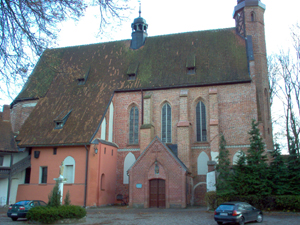
- This is Zukowo in
Poland, view from the northwest.
-
- The
church is made of
brick, in the shape of an elongated rectangle with incorporated
triangularly closed chancel.
- It was built in several phases: during
about half of the 13th century four western bays were built.
-
They were lower than they are presently, with a narrow tower in the shape
of half of the octagon
- (the initial height is marked from the outside by
the plaster friezes below the windows and the outline
- of the semi peaks on
the sides of the tower); in the 14th century the church was
continuously
- being elongated and heightened until it reached it’s
present size, in the north an outbuilding with the
- treasury and the
sacristy (present-day chapel) was added; there are dual or triple windows
-
and in their closures we find traceries composed of false stone; the interior
was initially
- covered with a ceiling. In the first decades of the 14th
century it was vaulted
- (barrel cap vaulting). At the same time a vaulted
gallery for the nuns was built into the three bays.
- The monastic buildings
were demolished in 1863; only the reconstructed fragment adjoining the
-
western part of the church from the south and the transformed building
southeast
- of the church has survived.
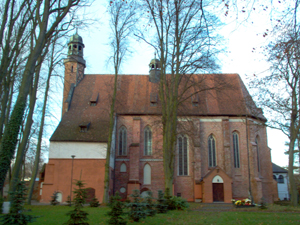
View from the south
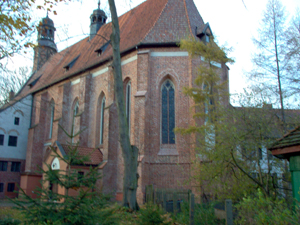
View from the southeast.
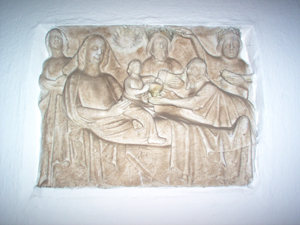
- Alabaster Tablet - Adoration of the Magi - c. 1380, 49x40 cm.)
-
- This
tablet is now situated on the eastern wall of the northern chapel, and is
English in origin.
- The
composition shows The
Adoration of the Magi consisting of six figures in a horizontal
rectangle.
- The
tablet presents a bed on which we see a half-lying figure of
Mary pillowed
- on the left and holding Baby Jesus. There is a woman by the
left edge.
- On the right, there are individualised figures of the Magi. Two
of them are standing
- behind the bed. On the axis of the composition, there
is a Magus with a beard wearing
- an open crown and holding a pot. By the
right edge there is the other Magus standing frontward
- without
a beard, also with an open crown, holding his gift in his left hand and pointing
- to the
star with his right. The star is on the left, next to the head of the
Magus presented
- in the
centre. The third Magus with a beard and bold is
shown by the right cushion of the bed.
- He is leaning low giving the glass
containing his gift to Jesus, who outstretches His little hands to reach
it.
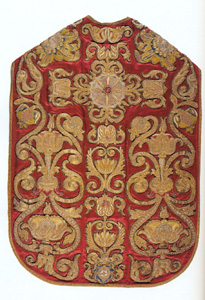
- Chasuble from Zukowo
-
- One of the specialties of the Convent at Zukowo was beautifully
ornamented embroidery.
- Embroidery was not a universal activity at Norbertine Convents, but
Zukowo was
- famous for its embroidery (just as the Spanish Convent of Toro is
today).
- This Chasuble was sewn/embroidered for the Abbot
- of the nearby Cistercian Abbey of Gdansk-Ollwa, Alexander Kesowski.
- He was abbot of that house from 1641-1667, and the chasuble
- was probably embroidered close to the end of his reign.
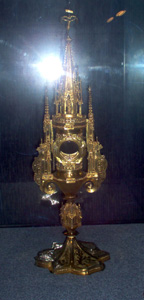
- Zukowo
Monstrance: c. 1450,
gilded silver, height 66 cm, foot 22x19 cm,
- Originally
from Gdansk, now in the
Parish
Museum
of Zukowo.
-
- This is a
tower-bell shaped monstrance. The sectors of the octagonal foot are
alternatively semicircular
- and ogive, decorated with engraved acanthus
leaves. The base has an openwork foil inscribed
- into rhombuses. The temple
node is separated by two hexagonal plates and crowned with
- tall polygonal
canopy. The temple-shaped case is mounted in side buttresses, topped with
tall spires from
- below and ends with ‘plastic cone’ volutes. The
buttresses hold the round host case. Above,
- there is a hexagonal tower
whose base is fitted with ogive arcades, which have mounting
- pinnacles and
turrets. In the space in between, there is a carved statue of
- The
Virgin and Child in "The
Beautiful Madonna"
style.
- The monstrance is topped with the arbor
vitae cross.

